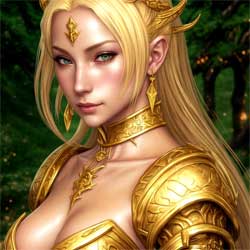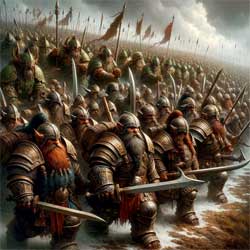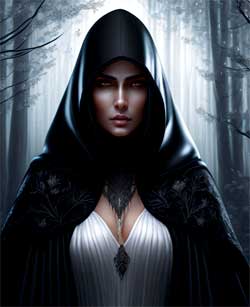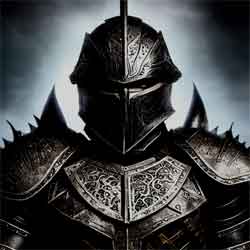|
A Brief History by Era
Synopsis by Jarinoth of Nithnamar, Wizard of the Great Council
Consultation: Scribe Tolni, Scribe Lmilnil, Historian Quint
- Age of Elyon
This is a long period when elves ruled Sesamar. More accurately, elves were caretakers.

Elves have been around a long time.
|
For the first 100 millennia, there were elves (wood or Evandera) who lived in harmony with other magical creatures of the forest. These creatures were sprites, pixies, satyrs, leprechauns, unicorns, brownies, and nixies. There was no need to venture from the forest, as their needs were met by it, so legends insist.
This is not to say life was always pleasant for these creatures. As we see in nature, the web of life sometimes rewards those who are strong and cruel. Sometimes many weak beings band together to reap great rewards, too.
It is unknown where elves and forest creatures came from, but elvish historians have ideas:
- They were the first creations of The Twin Gods on the Prime Material Plane.
- They came from a different plane, called the Ethergreen.
It is entirely possible these hypotheses are not mutually exclusive.
For some reason, certain elves (white or Loralanera) decided to venture from the forest. This likely occurred later in this era. These elves were no longer content with the forest, forest creatures, and magic alone. These elves began building a city near hills out of stones. These elves encountered gnomes, dwarves, and (half)lings.
The dwarves existed in the mountains. The gnomes lived in or near caves. Lings dwelled in homes built in the sides of hills or in prairies.
While no great feuds were thought to have erupted in this epoch, tensions did rise. The evidence to support this claim comes from the boundaries that were established. At the end of this era, each race (wood elves, white elves, dwarves, gnomes, and lings) had clearly defined territories.
Elyon is the elvish word for innocence. The last 10 millennia of this era are often referred to as Elyonillaia, which means innocence waning.
- Age of Delilaglog

Ale is a Life/Death Situation.
|
Delilalioni was a white elf king who led an effort to create and control an economy that included all the elves, dwarves, gnomes, and lings. The economy did not prevent strife but did create bitter rivalries. While each race wanted the resources that each other race had, no method could be found that would exactly satisfy all the races.
While no wars were recorded, skirmishes did ensue. Some battles did result with heavy casualties.
During the height of these losses, a direct descendant of King Delilalioni, King Gelilionie, experimented with magic. The magical arts were honed and were harmonious with nature.
Deliliaglog is a word that comes from the White Elf King Delilalioni and the dwarvish name for alcohol, which is glog. Dwarves had an entire economy based on glog. This era lasted for 30 millennia.
- Age of Mirgris

The Drow became drunk with dark depravity..
|
In an attempt to defeat the white elves, the drow (a then elvish cult) began dabbling in nefarious magics. These dark elves discovered necromancy, conjuration, and transmutation. With their dark arts, the drow slaughtered many non-drow. This forced the other races and sub-races of elves who had joint disdain for the drow to join forces against them. Consequently, the drow were literally driven far underground.
Consequently, the word 'drow' is synonymous with the word 'depths' in elvish. The drow themselves changed in appearance, becoming of such pale skin it became near translucent. It is at this stage the drow became a new race of elves, called Televera.
Not surprisingly, magics so powerful do not disappear so easily. These magics proved to be damming to those who used them. Practitioners too often abused them by exacting vicious tolls on other races for petty reasons. Users of these dark arts were quick to spiral down to depravities, like desires for power, riches, lusts, and such.
One infamous drow is known to be Queen Hantantamilius. She conjured xorn from the Elemental Plane of Earth. She created ropers and purple worms. Toward the end of her wretched life, she created horrific creatures: otyogh and neo-otyogh. The latter two creations served as excellent defensive measures against intruders to drow lairs.
To respond to the horrors of Queen Hantantamilius, elves learned and used the dark arts to create humanoids: nymphs, humans, sylphs, ... While all of the humanoids looked similar to each other, they each had their own special gifts. The sylphs and nymphs were magical creatures. The humans, while able to learn magic, did not take their wizardry from enchanted forests nor the wild. Their magic was learned like a trade, rich with verbal and semantic nuances.
Humans took quickly to all of the magical arts, like brightly lit candles. The complexity of their magics were intense. It is as if the shorter lifespan fueled a desire to master the magical arts and conquer the world around them.
Despite their lack of longevity, humans were powerful and rebellious like the other humanoids. They became so powerful, Queen Hantantamilius created a special transmutation to deal with them, namely umber hulks who have a strong taste for humans. Still, humans proved too strong and had too much ingenuity to be dominated by the drow.
The drow were slaughtered by the humans, led by a (human) King Mirgris.
This terrible era lasted 5 millennia.
As a side note, humans must have been heavily influenced by dwarves. When they named the two halves of the human dyad, humans chose the terms 'male' and 'female'. Both names contain a reference to ale -- See Age of Delilaglog.
- Age of Neltinus

Hobgoblins are smarter, taller than orcs.
|
With the drow laid to waste, the unification of the rest of the races also died. This led to conflicts between dwarves, elves, and humans. Gnomes and lings were able to escape these conflicts. Gnomes retreated to their caves to be content with tinkering with things and lings returned to innocence by settling in their rolling pastures.
It is in this era that lings began being referred to as halflings because of their similar, but smaller appearance to humans. Half-elves, once entirely shunned, began being accepted among humans.
Elves gained a military advantage over dwarves and drove them into their mountain cities. Dwarves began heavily mining their mountains. They found metals, some precious metals, and gems. Driven to find more beauty that rested in the earth, in their greed they discovered kobalds and goblins, who were also released from the depths of the mountains.
The sheer number of kobalds and goblins made them an existential threat to all creatures. Once again, the dwarves, elves, and humans found themselves unified in fighting these menaces. There was a gigantic war that resulted in the deaths of nearly 3 out of 4 humans, elves, and dwarves.
The war with these creatures are called the Kolin Wars, which is an amalgam of the words kobald and goblin. This is also the genesis for the human word 'colon,' for the great waste of this era.
This era is most known for two half-elves, named Hobxin and Taurma.
Hobxin (fighter/magic-user) and Taurma (cleric/magic-user) came by the dark magics of Queen Hantantamilius. They retreated to their tower to the east and were thought to have vanished from common existence. It soon became apparent they did not disappear but were busy with their transmutations.
Hobxin created hobgoblins [human/goblin], bugbear [bear?/goblin], and merman [elf/fish].
Taurma created the taur [tauren (human/bull), orc (human/pig), and tauron (human/lion)], nagea [human/snake], and medusae [human/snake].
Bugbears, hobgoblins, and orcs reproduced in large numbers. The creation of these vile things forever created a permanent alliance, however tenuous, between all good races.
It was also determined that all magic use be scrutinized by councils, orders, or groups of some kind. The horrors that it can produce can destroy all life, which is seen as an abhorrence to Sesamar and Desamar, who are worshipped directly at the end of this era. Even druids agree with this view of magic, as it can send the delicate balance of life off-kilter.
Neltinus is the name of a human chronicler who tirelessly spent his entire life collecting and organizing knowledge of historical events and hypotheses, which is why he is known for this era. This era lasted 2 millennia.
- Age of Salamundi (Eek/Eke)

Dragons struck fear in the hearts of champions.
|
Several forces from a lower plane of existence summoned colored dragons that were intent on wiping out all intelligent life. While those forces are not entirely known, it is known that this event was matched by forces from a higher plane of existence, gating in several metal-colored dragons who sought to foil the attempts of the other dragons.
This became known as the Dragon War, which lasted two hundred years. During this time, the earth was scorched, gassed, poisoned, or worse by dragon breath. 9 out of 10 living non-elves were destroyed.
This was the driving force that led leaders to dig deep and dwell underground. Only beings who learned how to live underground and scurry to gain food were able to survive.
It was thought the elves escaped the wrath of these flying lizards by fading into the Ethergreen.
As a side note, linguists tell us the terms 'eek' and 'eke' comes from this era. Creatures who saw approaching dragons would screech with an 'eek,' while survival required 'eke-ing' an existence.
The war ended with all the dragons being mutually annihilated, which also took out a sizable number of orcs, goblins, and kobalds who were involved in the struggles of this era.
It has been distinctly noted that the husks of dragons quickly dissolved into the soil.
- Age of (False?) Hope
For two hundred years following the Dragon Wars, conflicts with evil creatures, while present, were less intense. Conflicts were scattered and unorganized. It led to a feeling of growing hope within humans, elves, and dwarves alike.
However, the number of evil creatures began to grow. Besides having hordes of orcs, goblins, hobgoblins, and kobalds to contend with, new enemies and obstacles emerged. Lizard Men and Giants from the south and north within the Western Lands arose, respectively. In the Eastern Lands, ogres to the south sought to destroy the good races, as well.
Less than a hundred years ago, the environment became harsher. The sea became tumultuous with its tornadic waterspouts, massive waves, and giant eddies. The air sometimes blows with great force and turbulence. Volcanoes routinely erupt, the earth shakes, and seasons are more intense.
It is as if the evil became so great it sought to destroy everything.
The irony of this era is that hope is in short supply. So far, this era has lasted slightly more than 2 millennia.
|
|
|

